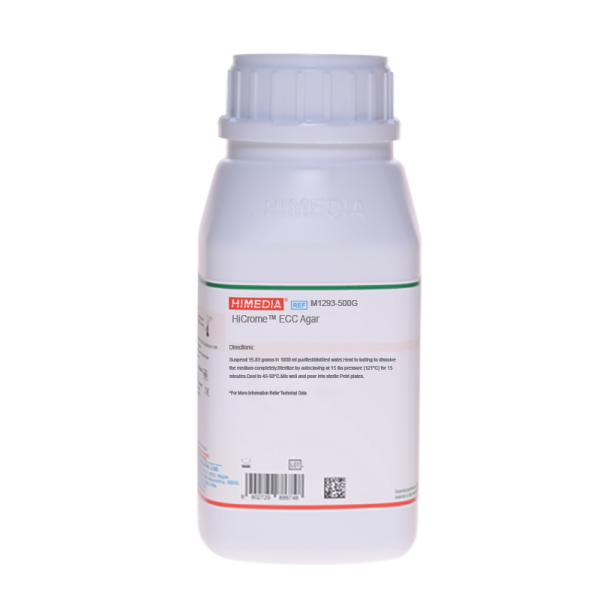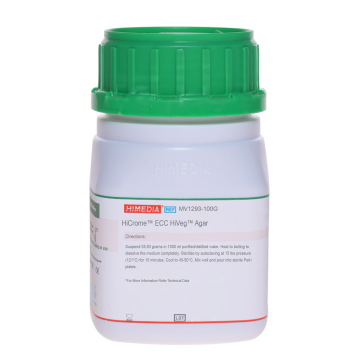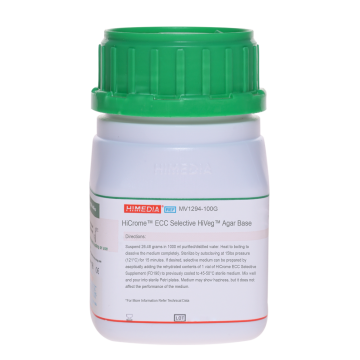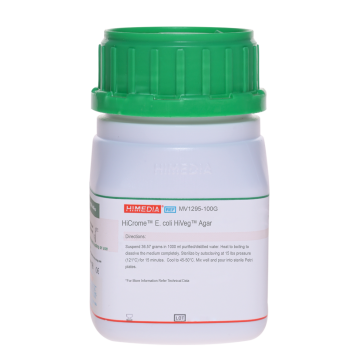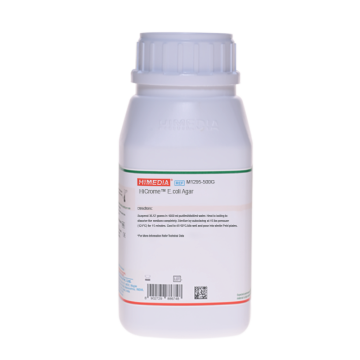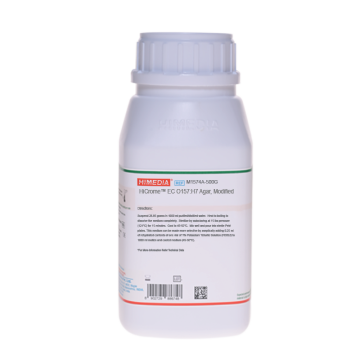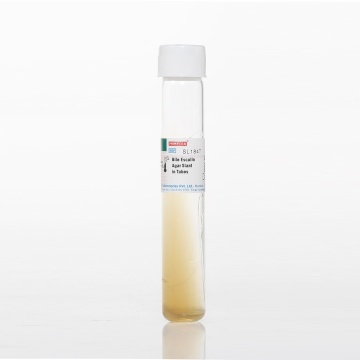 Your enquiry has been submitted
Your enquiry has been submitted
HiCrome™ ECC Agar
Intended Use:
Recommended as a differential medium for presumptive identification of Escherichia coli and other coliforms in food, environmental samples.
Composition**
| Ingredients | g/L |
|---|---|
| Peptone, special | 5.000 |
| Yeast extract | 3.000 |
| Lactose | 2.500 |
| Disodium hydrogen phosphate | 3.500 |
| Potassium dihydrogen phosphate | 1.500 |
| Sodium chloride | 5.000 |
| Chromogenic mixture | 20.300 |
| Neutral red | 0.030 |
| Agar | 15.000 |
| Final pH (at 25°C) | 6.8±0.2 |
**Formula adjusted, standardized to suit performance parameters
Directions
Suspend 55.83 gram in 1000 ml purified/ distilled water. Heat to boiling to dissolve the medium completely. Sterilize by autoclaving at 15 lbs pressure (121°C) for 15 minutes. Cool to 45-50°C. Mix well and pour into sterile Petri plates.
Principle And Interpretation
Escherichia coli, a member of the family Enterobacteriaceae is a part of normal flora of the intestinal tract of humans and a variety of animals. Although most of E.coli does not cause gastrointestinal illnesses, certain groups of E.coli can cause life-threatening diarrhoea and sever sequelae or disability (1). HiCrome™ ECC Agar is a differential medium recommended for the presumptive identification of E.coli and other coliforms in food and environmental samples (2). The medium contains two chromogens. One of the chromogen is cleaved by the enzyme glucuronidase produced by E.coli to give blue to purple coloured colonies whereas the other chromogen is cleaved by the enzyme galactosidase, produced by majority of coliforms, resulting in the formation of rose-pink coloured colonies (3,4).
Peptone special, yeast extract provide nitrogenous, carbonaceous substances, long chain amino acids, vitamin B complex and other essential growth nutrients. Lactose is the fermentable carbohydrate, which aids in detecting lactose fermenters with neutral red as an indicator. Disodium hydrogen phosphate and potassium dihydrogen phosphate buffers the medium well. Sodium chloride maintains the osmotic equilibrium. Dry the surface of plate medium.
Dilute the food sample by 1:5 or 1:10 with 0.1% sterile Peptone Water (M028) and homogenize in a blender or a stomacher. Spread 0.5 ml or 1.0 ml of the homogenate over the agar surface with a sterile glass spreader and incubate the plates at 37°C for 18-24 hours. Count the blue/purple colonies and multiply with the dilution factor. The number of E.coli is reported per gram of food. Wear mask while handling the dehydrated product and avoid contact with eyes.
Type of specimen
Food and environmental samples
Specimen Collection and Handling
For food samples, follow appropriate techniques for sample collection and processing as per guidelines (5).
For environmental samples, follow appropriate techniques for sample collection and processing as per guidelines (6,7). After use, contaminated materials must be sterilized by autoclaving before discarding.
Warning and Precautions
Read the label before opening the container. Wear protective gloves/protective clothing/eye protection/face protection. Follow good microbiological lab practices while handling specimens and culture. Standard precautions as per established guidelines should be followed while handling specimens. Safety guidelines may be referred in individual safety data sheets.
Limitations
- B-glucuronidase is present in 97% of E.coli strains, however few E.coli may be negative.
- Some species may show poor growth due to nutritional variations.
- Further biochemical and serological test are necessary for confirmation.
Performance and Evaluation
Performance of the medium is expected when used as per the direction on the label within the expiry period when stored at recommended temperature.
Quality Control
Appearance Light yellow to pink homogeneous free flowing powder
Gelling Firm, comparable with 1.5% Agar gel
Colour and Clarity of prepared medium Reddish pink coloured, opaque gel forms in Petri plates
Reaction Reaction of 5.58% w/v aqueous solution at 25°C. pH: 6.8±0.2
pH 6.60-7.00
Cultural Response Cultural characteristics observed after an incubation at 35-37°C for 18-24 hours.
| Organism | Inoculum Growth (CFU) | Recovery | Colour of Colony | |
|---|---|---|---|---|
| Escherichia coli ATCC 25922 (00013*) | 50-100 | luxuriant | >=70% | blue/purple |
| Pseudomonas aeruginosa ATCC 27853 (00025*) | 50-100 | good-luxuriant | >=70% | straw |
| Klebsiella pneumoniae ATCC 13883(00097*) | 50-100 | luxuriant | >=70% | rose/pink |
| Salmonella Enteriditis ATCC 13076 (00030*) | 50-100 | luxuriant | >=70% | pink |
Key : *Corresponding WDCM numbers.
Storage and Shelf Life
Store between 15-25°C in a tightly closed container and the prepared medium at 2-8°C. Use before expiry date on the label. On opening, product should be properly stored dry, after tightly capping the bottle in order to prevent lump formation due to the hygroscopic nature of the product. Improper storage of the product may lead to lump formation. Store in dry ventilated area protected from extremes of temperature and sources of ignition Seal the container tightly after use. Product performance is best if used within stated expiry period.
Disposal
User must ensure safe disposal by autoclaving and/or incineration of used or unusable preparations of this product. Follow established laboratory procedures in disposing of infectious materials and material that comes into contact with sample must be decontaminated and disposed of in accordance with current laboratory techniques (6,7).
Reference
- Doyle M. P., (Ed.), 1989, Foodborne Bacterial Pathogens, Marcel Dekker, New York
- Frampton E.W., Restaino L. and Blaszko N., 1988, J. Food Prot., 51:402.
- Kilian M. and Bülow P., 1976, Acta. Pathol. Microbiol. Scand., Sect. B, 84:245.
- Kilian M. and Bülow P., 1979, Acta. Pathol. Microbiol. Scand., Sect. B, 87:271.
- Salfinger Y., and Tortorello M.L. 2015, Compendium of Methods for the Microbiological Examination of Foods, 5th Ed., American Public Health Association, Washington, D.C.
- Isenberg, H.D. Clinical Microbiology Procedures Handbook. 2nd Edition.
- Jorgensen, J.H., Pfaller, M.A., Carroll, K.C., Funke, G., Landry, M.L., Richter, S.S and Warnock., D.W. (2015) Manual of Clinical Microbiology, 11th Edition. Vol. 1.
| Product Name | HiCrome™ ECC Agar |
|---|---|
| SKU | M1293 |
| Product Type | HiCrome™ |
| Physical Form | Powder |
| Origin | Animal |
| Packaging type | HDPE |
| References | 1.Doyle M. P., (Ed.), 1989, Foodborne Bacterial Pathogens, Marcel Dekker, New York2.Frampton E.W., Restaino L. and Blaszko N., 1988, J. Food Prot.,51:402. |
| Customized Product Available | No |



